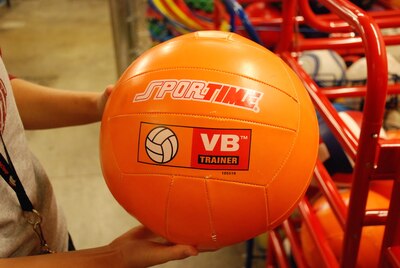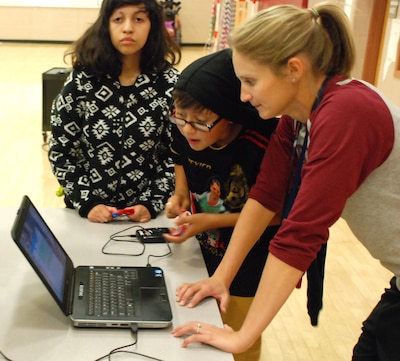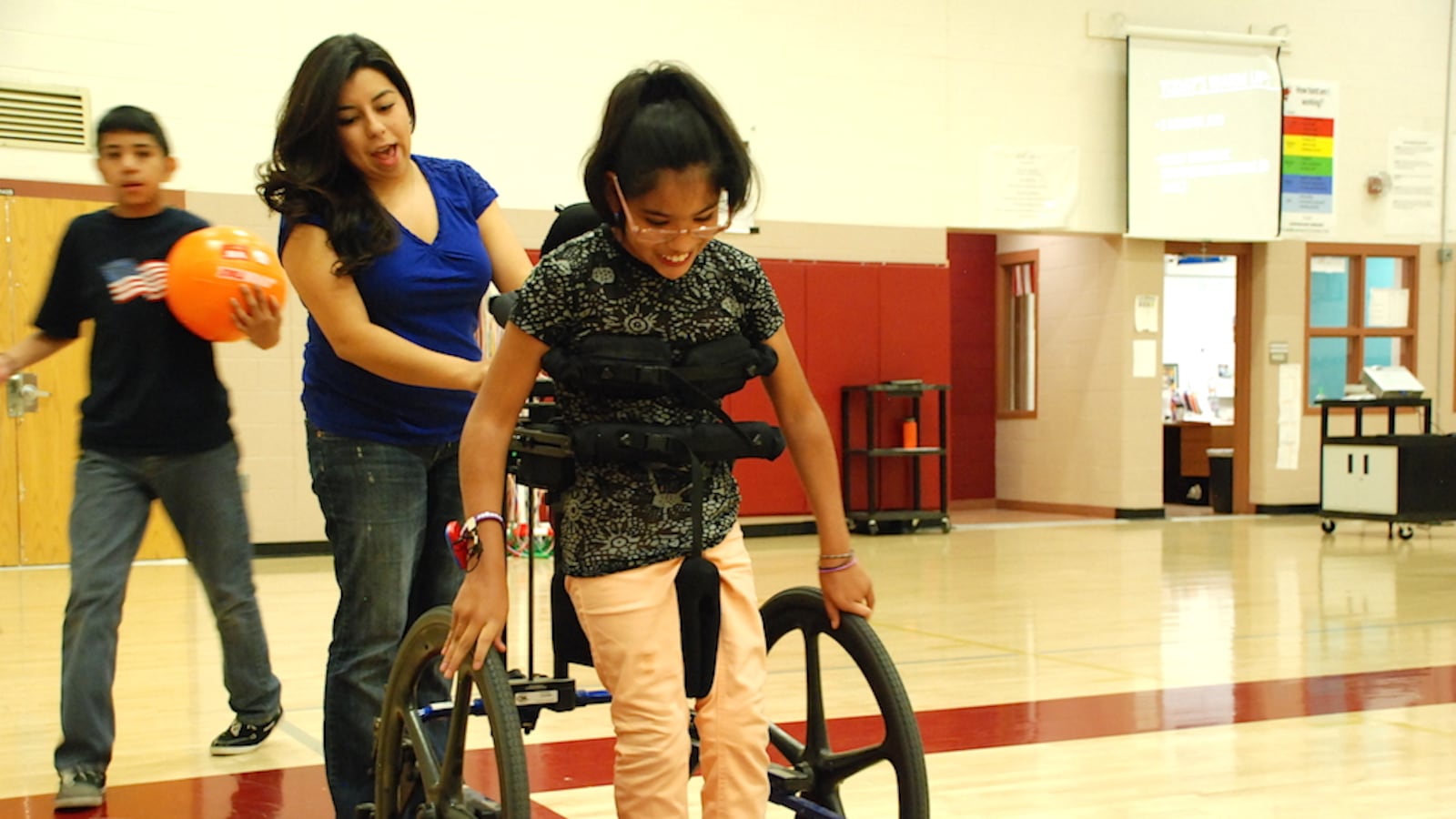Ignacio wore a bright orange pedometer, but he wasn’t counting steps. The Denver seventh-grader was using the device strapped to his wrist to count each push of his wheelchair wheel as he circled the gym during warm-ups.
Later in the physical education class at Bruce Randolph School, Ignacio tossed a basketball back and forth with an aide and the pedometer tallied that movement too. His 19 classmates—with disabilities ranging from autism to cognitive delays—also wore pedometers.
The devices, which track both steps and physical activity minutes, represent one way that Denver Public Schools are ensuring that students with disabilities have equitable physical education experiences—comparable though not exactly the same as their general education peers.
Over the last five years, the district has made efforts to improve physical education for special needs students. The district spent about $50,000 on modified sports equipment—things like lighter-weight balls or balls that beep—for 56 district schools. It has also brought in out-of-state experts to run trainings on adapted P.E, most recently in 2014.
In part, the push has come from the district’s Health Agenda 2015—a five-year plan outlining key health priorities including improvements to physical education.
DPS officials say the district’s teacher evaluation system LEAP, launched districtwide in 2012, has also played a role by explicitly mandating differentiation—customized instruction based on student needs.
“Before, I think it was more of an implied understanding,” said Kelley Morrison, supervisor of the district’s occupational and physical therapy department. “There wasn’t as much emphasis, so we may not have been as aggressive…Now, it’s more spelled out.”

In the class at Bruce Randolph—an adapted P.E. class specifically for students with disabilities—there were plenty of choices and at least four staff members to help facilitate. It was the culmination of a ball sports unit and some students joined a fast-paced soccer game next to the bleachers. Others dribbled basketballs on the far side of the gym. A few practiced kicking and throwing on their own, or like Ignacio, with a paraprofessional.
When one boy, who wore leg braces under his jeans lingered off to the side with his arms folded across his chest, teacher Whitney Darlington quickly spotted him and said, “What’s up bud?”
He told her his legs were tired from hula-hooping during the warm up period. After a quick pep talk, he accepted what looked like an oversized orange volleyball from Darlington and began bouncing it off the wall to himself.
Not included
In another era, or even now in some districts around the country, Darlington’s students might have experienced a very different P.E. class.
Although the federal Individuals with Disabilities Education Act requires schools to provide physical education to students with disabilities, it’s not unheard of for them to be shunted aside when it comes time for class.
They might be set up with a game of chess or checkers, or scheduled for physical therapy during P.E.
David Martinez, an adaptive physical education specialist from Georgia who’s conducted trainings for Denver Public Schools staff, said kids are sometimes invited to participate in an empty way.
They’ll be told, “‘Today, you’re going to be the scorekeeper,” or ‘Today, you’re going to be the official.”
Worse yet, “Some students may not even make it to the gymnasium, they may be left in the classroom.”
Greeley-Evans teacher Kelly Kennedy, who was recently named Colorado’s Adapted Physical Education Teacher of the Year, said she believes physical education opportunities for students with disabilities have improved over the years.
“As a profession, we’ve gotten so much better at being able to adapt and modify for students,” she said.
It can be as simple as providing a ramp to roll a ball up instead of requiring a student to throw it. Or hanging a hula hoop from the the basketball hoop to create a more manageable target.
Bruce Randolph parent Melissa Smith said she’s been happy to see her daughter Alissa, who has a congenital heart defect and cognitive delays, get the same P.E. opportunities as her peers—things as small as learning how to jump rope.
“These kids are being treated a lot more like the general population,” she said.
Smith has heard “back-in-the-day” stories about special education students being sidelined during P.E., but said it’s never happened to Alissa.
In fact, physical education is her daughter’s favorite class, she said.
More money, more guidance needed
While awareness is higher than it used to be, funding constraints and a dearth of teacher training remain challenges.
A 2010 report from the federal Government Accountability Office found that students with disabilities had similar opportunities to participate in P.E. as their general education peers, but that teachers didn’t always know how to fully include them, were unclear about requirements under federal law and didn’t have regular access to trainings on these topics.
Another problem is that more than two-thirds of states—including Colorado—don’t offer a teaching license or endorsement in adapted physical education. Kennedy, who holds an adapted P.E. teaching license from Minnesota, said a state advisory committee is working with the Colorado Department of Education to create that credential here. Currently, the department recommends that teachers interested in adapted P.E. positions seek a national credential from the National Consortium for Physical Education and Recreation for Individuals with Disabilities.
Ideally, every district would have at least one adapted physical educator, say Kennedy and Martinez. It’s a role that typically includes some teaching as well as consulting with general education P.E. teachers who have students with disabilities in their classes.
In Colorado, the state education department doesn’t track how many districts employ adapted physical educators. In Greeley-Evans, Kennedy is one of two such teachers. In Denver, there are no adapted P.E. teachers.
Personal improvement
At the end of Darlington’s P.E. class at Bruce Randolph, Ignacio and his classmates crowded around her to plug their pedometers into docking stations and check their results. The stats, which get posted on the gym bulletin board (by student numbers not name), students how hard they’re working during class and how they’ve improved over time.

“I think I did more,” said Ignacio, when it was his turn.
He was right. The previous week he’d completed 4 minutes and 49 seconds of “moderate to vigorous physical activity” in the class, and now his numbers were up to 6 minutes and 13 seconds.
It was a far cry from the amount clocked by his most active soccer-playing classmate— nearly 29 minute in the moderate to vigorous range. But for Ignacio it was a win.
Before the pedometers, he liked to stick by Darlington’s side and talk at length about baseball. Now, he’s pushing himself a little harder.
“It’s pretty awesome,” she said.

